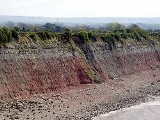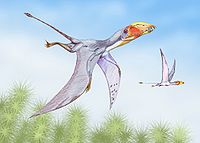
Aust Cliff
Encyclopedia
Aust Cliff is a 5.3 hectare
geological Site of Special Scientific Interest adjacent to the Severn Estuary
, near the village of Aust
, South Gloucestershire
, notified in 1954. The Severn Bridge
crosses the cliff.
Its SSSI designation is due to the presence of fossil
beds. The site is famous for its Rhaetic
bone bed
, and is also the most productive locality in Britain for Triassic
insects.
The lower part of the cliff is a red mudstone
, with bands of nodules of pinkish-white alabaster
. Above the red mudstone is green mudstone, followed by the Rhaetic bone bed at the base of a band of black shale. Above the shale are cream-coloured limestone
beds.
Hectare
The hectare is a metric unit of area defined as 10,000 square metres , and primarily used in the measurement of land. In 1795, when the metric system was introduced, the are was defined as being 100 square metres and the hectare was thus 100 ares or 1/100 km2...
geological Site of Special Scientific Interest adjacent to the Severn Estuary
Severn Estuary
The Severn Estuary is the estuary of the River Severn, the longest river in Great Britain. Its high tidal range means it has been at the centre of discussions in the UK regarding renewable energy.-Geography:...
, near the village of Aust
Aust
Aust is a small village in South Gloucestershire, England, the historical site of the eastern terminal of the Aust Ferry crossing route over the River Severn between England and Wales, believed to have been used in Roman times as a continuation of Icknield Street which led from Eastern England...
, South Gloucestershire
South Gloucestershire
South Gloucestershire is a unitary district in the ceremonial county of Gloucestershire, in South West England.-History:The district was created in 1996, when the county of Avon was abolished, by the merger of former area of the districts of Kingswood and Northavon...
, notified in 1954. The Severn Bridge
Severn Bridge
The Severn Bridge is a suspension bridge spanning the River Severn between South Gloucestershire, just north of Bristol, England, and Monmouthshire in South Wales, via Beachley, a peninsula between the River Severn and River Wye estuary. It is the original Severn road crossing between England and...
crosses the cliff.
Its SSSI designation is due to the presence of fossil
Fossil
Fossils are the preserved remains or traces of animals , plants, and other organisms from the remote past...
beds. The site is famous for its Rhaetic
Rhaetian
The Rhaetian is in geochronology the latest age of the Triassic period or in chronostratigraphy the uppermost stage of the Triassic system. It lasted from 203.6 ± 1.5 to 199.6 ± 0.6 million years ago...
bone bed
Bone bed
A bone bed is any geological stratum or deposit that contains bones of whatever kind. Inevitably, such deposits are sedimentary in nature. Not a formal term, it tends to be used more to describe especially dense collections...
, and is also the most productive locality in Britain for Triassic
Triassic
The Triassic is a geologic period and system that extends from about 250 to 200 Mya . As the first period of the Mesozoic Era, the Triassic follows the Permian and is followed by the Jurassic. Both the start and end of the Triassic are marked by major extinction events...
insects.
The lower part of the cliff is a red mudstone
Mudstone
Mudstone is a fine grained sedimentary rock whose original constituents were clays or muds. Grain size is up to 0.0625 mm with individual grains too small to be distinguished without a microscope. With increased pressure over time the platey clay minerals may become aligned, with the...
, with bands of nodules of pinkish-white alabaster
Alabaster
Alabaster is a name applied to varieties of two distinct minerals, when used as a material: gypsum and calcite . The former is the alabaster of the present day; generally, the latter is the alabaster of the ancients...
. Above the red mudstone is green mudstone, followed by the Rhaetic bone bed at the base of a band of black shale. Above the shale are cream-coloured limestone
Limestone
Limestone is a sedimentary rock composed largely of the minerals calcite and aragonite, which are different crystal forms of calcium carbonate . Many limestones are composed from skeletal fragments of marine organisms such as coral or foraminifera....
beds.
Paleofauna
| Pterosaur Pterosaur Pterosaurs were flying reptiles of the clade or order Pterosauria. They existed from the late Triassic to the end of the Cretaceous Period . Pterosaurs are the earliest vertebrates known to have evolved powered flight... s of Aust Cliff |
||||
|---|---|---|---|---|
| Taxa | Abundance | Notes | Images | |
Genus:
|
 |
|||

